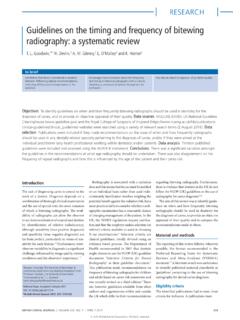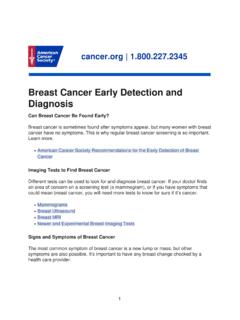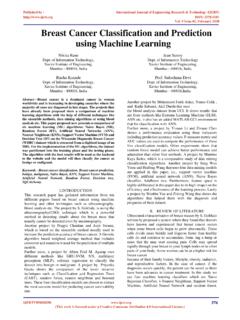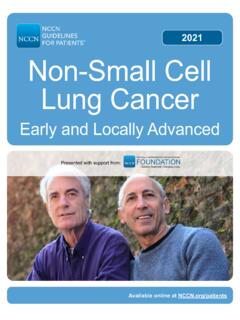Transcription of EARLY DETECTION AND PREVENTION OF ORAL CANCER: a ...
1 Occasional paper EARLY DETECTION AND. PREVENTION OF ORAL. cancer : a management strategy for dental practice PUBLISHED BY THE BRITISH DENTAL ASSOCIATION. Editors: Paul Speight, Saman Warnakulasuriya and Graham Ogden EARLY DETECTION AND PREVENTION OF ORAL cancer : a management strategy for dental practice EARLY DETECTION of oral cancer needs more than just Oral cancer deaths will be reduced only if the disease understanding of the signs and symptoms of disease. is recognised earlier, avoiding delays in diagnosis, and The process must be managed effectively and handled treated Greater public awareness, Continuing sensitively. Every member of the dental team has a Professional Education and improvements to the health part to play and protocols should be developed for (referral) systems, we believe, will help us to achieve effective delivery of: this objective.
2 1. regular examination of the oral cavity of patients This care pathway is a revised version of BDA. attending the practice Occasional Paper issue number 6, released in April 2000, and includes advances in knowledge made since 2. management of detected mucosal lesions with the previous publication. appropriate referral BDA Occasional Papers are published under the 3. management of patients with lifestyles that editorial control of the BDA. The present paper was contribute to an increased risk of oral cancer . edited and updated for the BDA by Professor Paul Speight (University of Sheffield), Professor Saman The aim of this Occasional Paper is to develop a Warnakulasuriya (King's College London & WHO.)
3 Clinical guideline and offer realistic advice for dentists in Collaborating Centre for Oral cancer , UK) and primary care who now seek to adopt best practice in Professor Graham Ogden (University of Dundee). oral cavity examination and case DETECTION . British Dental Association 64 Wiimpole Street, London W1G 8YS. Tel: 020 7935 0875 Fax: 020 7487 5232. Copyright November 2010 All rights reserved ISBN 978-1-907923-00-5. BDA November 2010 2. Content Page Introduction 2. EARLY DETECTION of oral cancer - obligations and opportunities 4. How common is oral cancer ? 4. What can dentists do? And what should they do? 5. The first priority - primary PREVENTION 5.
4 Secondary PREVENTION - catching cancers EARLY 6. Tertiary PREVENTION - stopping recurrence and spread 7. Caring for patients with other forms of cancer 7. Frequency of examinations 8. Examination techniques 8. Risk factors 10. What causes oral cancer ? 10. Tobacco and alcohol use 11. Other risk factors 11. Special risks in minority ethnic communities in the UK 12. Talking to patients about oral cancer examinations 13. Information for consent 13. Information to improve patient understanding 13. Handling difficult questions 14. Using written information 14. Using simple language 14. Lifestyle counselling 15. Talking to patients from different cultures 16.
5 Talking about referrals 16. NICE guidelines for urgent referrals 17. Communication pathways 18. Administration 19. Medical history taking 19. Clinical records 19. Record keeping for adjunctive tests 20. Following up on patients at risk 20. Examining the head, neck and oral cavity 21. Extra-oral examination 21. Intra-oral examination 21. Signs and symptoms of oral cancer 22. Potentially malignant disorders 22. Other malignancies 24. Putting case DETECTION into practice 26. Developing practice guidelines 26. Agreeing the approach 26. Making the most of your resources 27. Auditing your care pathway 28. Working with other health professionals 28.
6 The key to success - everyone with a clear role 28. Team roles and responsibilities 28. For more help 30. Bibliography 32. Appendix 1 34. Appendix 2 35. Appendix 3 36. BDA November 2010 3. EARLY DETECTION of oral cancer obligations and opportunities Oral cancer remains a highly lethal disease The incidence of this cancer is increasing and is one of the most debilitating and in particular among young males. disfiguring of all malignancies. It presents the Oral cancer deaths are not falling in Britain whole dental team with important obligations, even though many are preventable. challenges and a real opportunity to save a Patients need to know that certain lifestyles life.
7 Some patients are now taking legal action put them at risk of oral cancer . against their dentist, alleging failure to The dental team has a key role in the diagnose their oral cancer . PREVENTION of oral cancer deaths by earlier DETECTION of any suspect conditions. This section introduces the key issues, which The dental team should understand NICE. are discussed more fully in later sections. guidelines for referral of suspect lesions. Practices should review their approach to The incidence of oral cancer in the UK has case finding and appropriate referral. been increasing since the mid 1970s;. incidence has increased by over 34 per Finally, on page 26, the paper looks at the cent in the last decade.
8 Practical implementation of an oral cancer DETECTION strategy. How common is Oral cancer includes cancers of the lip, tongue incidence. Furthermore, treatment of many oral cancer ? and rest of the oral cavity, but not cancers of cancers is showing impressive improvement in the major salivary glands. Those of the tonsil survival, but oral cancer continues to have and oropharynx are included as oropharyngeal high death rates. cancers. By this definition, there are currently over 5000 new oral cancer cases per year in The oral cancer challenge is put into the UK, and about 1850 deaths. Incidence is perspective in Table 1, which draws higher in men than in women, in older comparison with four other much-publicised compared with younger age groups and varies cancers.
9 Oral cancer has a worse ratio of from region to region, with Scotland, Wales deaths to cases compared with other cancers and Northern Ireland having a higher shown in the table. The five-year survival rate incidence of oral cancer than for oral cancer is low, with only 48-55 per cent surviving five years - compared with 71 per The problem is not simply that the number of cent survival following prostate cancer , 62 per new oral cancer cases is rising, as people cent following cervical cancer , 80 per cent continue to put themselves at risk through following breast cancer and 78-91 per cent smoking and excessive drinking, but also that following malignant melanoma.
10 These cancers are being detected at an advanced stage. No other cancers have Oral cancer is more common than cervical shown such significant increases in their cancer in the United Kingdom. Table 1. Registrations (R) and deaths (D) for various cancers - England, Scotland & Wales. (Data abstracted from cancer Research ). Site WHO International Classification Registrations Deaths D:R Ratio of Diseases: Codes ICD-10 2006 2007. Oral: lip,mouth Excluding major salivary glands & 5325 1851 tongue, pharynx nasopharynx Skin (melanoma) 172 10410 2042 Cervix 180 2873 941 Breast 174 45822 12082 Prostate 185 35515 10239 BDA November 2010 4.







